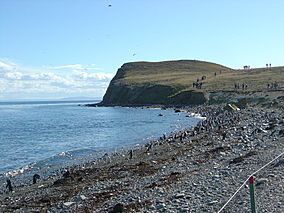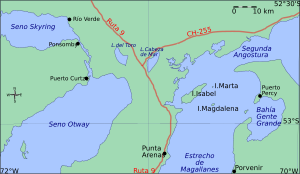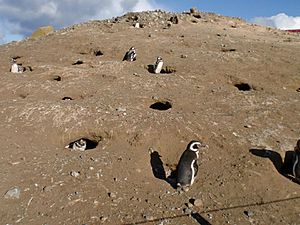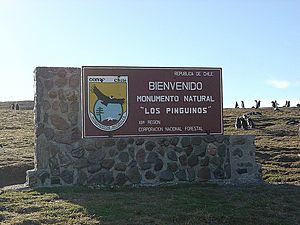Los Pingüinos Natural Monument facts for kids
Quick facts for kids Los Pingüinos Natural Monument |
|
|---|---|
|
IUCN Category III (Natural Monument)
|
|
 |
|
| Location | Magallanes Region, Chile |
| Nearest city | Punta Arenas |
| Area | 96 ha (0.37 square miles) |
| Established | 1966 |
| Governing body | Corporación Nacional Forestal (CONAF) |
The Los Pingüinos Natural Monument (which means "The Penguins Natural Monument" in Spanish) is a special place in Chile. It's about 35 kilometers (22 miles) northeast of Punta Arenas. This monument is mostly made up of two islands, Magdalena Island and Marta Island. They are located right in the middle of the Strait of Magellan.
These islands are home to the biggest penguin colonies in southern Chile! Imagine about 60,000 pairs of Magellanic penguins living here. Even though no humans live on the islands now, lots of tourists visit every summer. They come to see the penguins and other amazing wildlife. Magdalena Island is bigger, at 85 hectares, and gets most of the visitors. Marta Island is smaller, only 12 hectares, and fewer tours go there. The CONAF helps manage the monument. They work to protect the penguins and make sure tourism is safe for them.
Contents
History of the Islands
Long ago, before the 1500s, three groups of people lived near Magdalena and Marta Islands. These were the Selknam, the Yaghan, and the Kawésqar. They didn't live on the islands themselves very much. They spent most of their time fishing in the sea.
Later, Spanish settlers came to the area. They brought sheep, which changed the land. This made it harder for animals like the guanaco (similar to an alpaca) to live there. The Selknam people used to hunt guanacos, so they had to move away. The Yaghan and Kawesqar also left the area because of the new settlers.
The islands got their current names, Magdalena and Marta, from a Spanish explorer named Pedro Sarmiento de Gamboa in the 1500s. Not much is known about the islands' history from that time until today.
Protecting the Penguins
The Pingüinos monument was created in 1966. Its main goal was to protect the Magellanic penguins from too much fishing. Penguins eat the same fish that people catch. So, lots of fishing meant less food for the penguins, which hurt their population.
In 1982, the monument became a protected area. This meant that fishing was not allowed within 30 kilometers (18 miles) of the island. Also, the island was kept safe as a place for penguins to breed. Because of these rules, the penguin population has grown back! From 2000 to 2007, the number of penguins increased by 6%. Some penguins have even moved to a nearby island because Magdalena Island is getting full.
Island Climate
The weather on the islands is usually cold and rainy. The average temperature is about 8 degrees Celsius (46 degrees Fahrenheit). There aren't huge changes between seasons, just warmer summers and colder winters. In winter, temperatures can drop below freezing. In summer, they might reach 18 degrees Celsius (64 degrees Fahrenheit). The islands get about 43 centimeters (17 inches) of rain each year. Many visitors also say it's very windy!
Plants of the Islands
There aren't many types of plants on the islands. This is probably because of the cold, windy weather and the rocky ground. One type of short grass grows all over Magdalena island. This grass grows especially well in places where there are fewer animals. The ocean around Magdalena Island has a lot of kelp, which is a type of seaweed.
Animals of the Islands
The most famous animal at the monument is the Magellanic penguin. Over 60,000 pairs of these penguins live here! They are the main reason tourists visit.
Other important animals include the imperial shag, a type of bird. You can also see sea lions and South American fur seals resting on the islands. Two kinds of seagulls live here: the dolphin gull and the common gull. Some of the rocky shores are home to mussels.
Challenges for Penguins
Magellanic penguins are not an endangered species yet. But they are close to becoming threatened in some parts of South America. This is because they are losing their homes and food sources. On Magdalena Island, penguins have more chicks that survive than at other places. This is because human activity doesn't disturb them as much here.
Because penguins face problems elsewhere, protecting this monument is very important. The islands are a great place for penguins. There are not many predators, lots of food, and the islands are far from busy human areas. This is especially true when tourists are not allowed on the islands.
Tourism is managed well and doesn't cause big problems for the penguins. But there are other possible issues. One small concern is that parts of the shoreline are wearing away (erosion). This isn't happening fast, but over a long time, it could make the island smaller. This would mean fewer places for penguins to nest.
Another problem was seen in 2002–03 when fewer penguins were counted. Scientists think this was because of a drought the summer before. The drought killed a lot of the grass, which led to dust storms. These storms can destroy penguin nests. Since droughts hurt penguins so much, climate change is a serious worry. Climate change is expected to cause less rain, which could be very bad for the penguins.
Also, many ships carrying oil pass through the Strait of Magellan. This creates a risk of an oil spill. An oil spill would be very harmful to the penguins. If penguins get oil on their feathers, they can't stay warm in the water. They leave the water and can't hunt for food, so they starve. If they swallow oil, it can hurt their digestion and immune systems. It's hard to prevent these risks without stopping oil ships from using the Strait, which is a very big change.
What is a Natural Monument?
Natural monuments are one of three types of protected areas of Chile. The main goal of Chile's natural monuments is to protect special parts of nature. This could be plants, animals, or even the history and culture of a place. These sites are chosen because they are important to Chile's identity. They also show how people and nature connect.
The Los Pingüinos monument was created in 1966. It aims to keep the island a safe breeding place for penguins and other birds. It also protects Chile's cultural history, as native groups lived here hundreds of years ago. So, protecting the islands doesn't mean keeping all humans away. Instead, it means finding a way for people, wildlife, and the land to live together in a healthy way. Making it a natural monument helps both the penguins and Chile's natural and cultural treasures.
Visiting the Monument (Ecotourism)
The Los Pingüinos Natural Monument is open from October to March. During the rest of the year, the penguins are busy breeding. Humans are not allowed on the island then so they don't disturb the penguins. Also, the monument is closed in winter when the penguins are away and the weather is harsh.
For Chilean visitors, the entry fee is 3,000 Chilean pesos (CLP). For visitors from other countries, it's 5,000 CLP. You have to take a ferry from Punta Arenas with a tour company, which costs extra. There's a small museum on the island where you can learn about the monument's history and facts about penguins.
Besides the penguins, the island also has a lighthouse called Faro Isla Magdalena. It opened in 1901. Visitors can climb its spiral staircase, which is 14 meters (46 feet) high. From the top, you get a great view of the island and the ocean.
Ecotourism is a type of travel where visitors try to be responsible. They want to help protect nature and respect local communities. It can bring money to areas that don't have many other jobs. Ideally, ecotourists don't harm the place they visit. They also help the local economy.
Sometimes, ecotourists have different ideas about what they want. They want to see animals and nature as they are, but they also want to get very close to the penguins. These two ideas can be tricky. Penguins on the tourist side of the island act differently than those who don't see many humans. The penguins used to tourists are less scared of people. While this is good for visitors, it changes how the penguins naturally behave. Some scientists think that predators avoid penguins that nest near humans. This shows that human actions can have surprising results.
Ecotourism Concerns
There are some worries about how tourism might affect the penguins. For example, in other places, lots of fishing happens to feed tourists or because tourists want to fish. This can reduce the food for penguins.
Another concern is that penguins might change their behavior around humans. This could affect their survival. Studies show that penguins can get stressed when they meet humans. However, penguins who live at tourist sites seem to get used to people and show less stress. While Magellanic penguins might handle humans better than some other penguin species, it's still important to keep human effects on them as small as possible.
It takes time for penguins to get used to people. So, it's important to keep some parts of the island free from human visitors. This allows penguins to adapt from a distance before they feel comfortable nesting in areas where people visit.
Managing Tourism
Yearly checks of the penguin population on Magdalena Island show they are doing well. Tourism doesn't seem to be harming them. A monitoring program since 1999 helps keep track of the penguins. This allows managers to make sure the population stays healthy.
Several rules help keep the impact low. First, visitors must stay on marked paths and not cross ropes. The path is 850 meters (2,788 feet) long and goes through much of the island. But it leaves large areas where humans can't go. By keeping tourists in certain areas, the effects of many visitors are reduced. Penguins also have places where they can avoid human stress.
Also, fishing is not allowed within 30 kilometers (18 miles) of the islands. This means fishing isn't a tourist activity. This rule helps protect the penguins' food source.
Another helpful thing is the information given to tourists. The ferry ride to the island takes about an hour. Most tour companies show a video and explain what to expect and how to behave. This information is very important for limiting human impact. The ferry system also creates many jobs for local people. This includes boat drivers, tour guides, and staff who sell food. This helps the Los Pingüinos monument bring money to the area without harming the environment.
See also
 In Spanish: Monumento natural Los Pingüinos para niños
In Spanish: Monumento natural Los Pingüinos para niños




